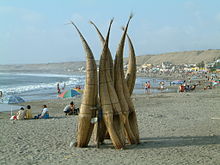Caballito de Totora

As Caballito de Totora , Spanish for "reed horses", are in Peru traditionally made small fishing boats called. The name Caballito, as a diminutive of the Spanish word for "horse" ( el caballo ), probably goes back to the fisherman's sitting posture , which is similar to a rider , with both legs in the water. The addition of the name de Totora is derived from the Totora plant used for construction Reeds off.
A Caballito de Totora has the shape of a pod and is woven from reeds. In terms of size, with a length of four to five meters , a width of 0.6 to one meter and a payload of around 200 to 250 kilograms, it is sufficient for transporting one person, fishing gear and catching. A Caballito de Totora is propelled by paddling . They are particularly widespread in northern Peru, where the construction and use of these boats has a tradition that is probably thousands of years old and goes back to the Moche culture .
The Caballito de Totora was declared a National Heritage of Peru ( Patrimonio Cultural de la Nación ) by the Peruvian Cultural Institute ( Instituto Nacional de Cultura del Perú , INC) in 2003 , as it is an expression of the cultural life in the northern coastal regions of the country and one Part of the regional and national identity.
literature
- Hans Horkheimer: Food and food production in pre-Hispanic Peru. Series: Bibliotheca Ibero-Americana. Volume 2. Colloquium Verlag, Berlin 1960, p. 49
- The Use of the Sea. In: César Ferreira, Eduardo Dargent-Chamot: Culture and Customs of Peru. Greenwood Publishing Group, Westport and London 2003, ISBN 03-13-30318-5 , p. 12
- Resolucion Directoral Nacional N ° 648 / INC. Lima, 27 de agosto de 2003. Decision of the Instituto Nacional de Cultura del Perú, Lima 2003
Web links
- El Caballito de Totora en la Historia video documentation (Spanish, about eight minutes running time)
